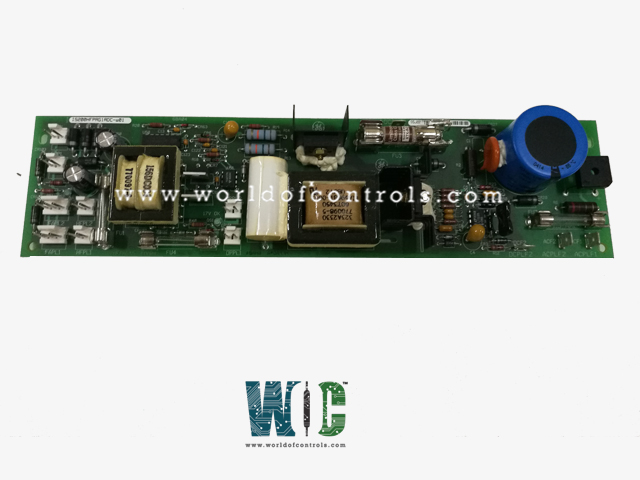
World Of Controls understands the criticality of your requirement and works towards reducing the lead time as much as possible.
IS200HFPAG1A - High-Frequency Power Amplifier Module is available in stock which ships the same day.
IS200HFPAG1A - High-Frequency Power Amplifier Module comes in UNUSED as well as REBUILT condition.
To avail our best deals for IS200HFPAG1A - High-Frequency Power Amplifier Module, contact us and we will get back to you within 24 hours.
SPECIFICATIONS:
Part Number: IS200HFPAG1A
Manufacturer: General Electric
Series: Mark VI
Product Type: High-Frequency Power Amplifier Module
Technology: Surface Mount
Analog output current: 0-20 mA
Operating temperature: -30 to 65°C
Size: 5.91 x 4.72 x 1.57 inches
Repair: 3-7 Day
Availability: In Stock
Weight: 2lbs
Country of Origin: United States
Manual: GEH-6385
FUNCTIONAL DESCRIPTION:
IS200HFPAG1A is a High-Frequency Power Amplifier Module manufactured and designed by General Electric as part of the Mark VI Series used in GE Speedtronic Gas Turbine Control Systems. High-Frequency Power Amplifier Modules (HF PAMs) are essential electronic devices used to amplify radio frequency (RF) signals, operating typically in the range of megahertz (MHz) to several gigahertz (GHz). These modules are crucial in various applications, including telecommunications, broadcasting, and radar systems, where they boost weak input signals to ensure effective transmission. HF PAMs consist of several stages: the input stage filters the incoming signal, the amplification stage utilizes active devices like transistors to increase the signal power, and the output stage ensures proper impedance matching and filtering. Key specifications of these amplifiers include frequency range, gain (measured in decibels), output power, efficiency, linearity, and thermal management capabilities. Different types of HF PAMs, such as Class A, Class B, Class AB, and Class C amplifiers, offer varying trade-offs between linearity, efficiency, and power output. Proper design considerations, including temperature management, power supply requirements, and modulation types, are vital for optimizing performance and reliability. Overall, HF PAMs are pivotal in enhancing signal quality and strength in a wide range of modern electronic systems.
FUNCTIONS:
Signal Amplification: In gas turbine control systems, HF PAMs amplify control signals from sensors that monitor various operational parameters, such as temperature, pressure, and speed. These sensors produce low-level signals that require amplification to be processed effectively by the control system. The ability to boost these signals ensures that the control system receives accurate and reliable data for decision-making.
Control Signal Transmission: Gas turbine systems rely on precise control signals to adjust fuel flow, ignition timing, and turbine speed. HF PAMs are responsible for amplifying these control signals to a level suitable for transmission to actuators and valves. This amplification is crucial for ensuring that the control signals maintain their integrity and reach the necessary components without significant loss or distortion.
Impedance Matching: Impedance matching is critical in gas turbine control systems to ensure that the electrical signals are transferred efficiently between components. HF PAMs are designed to match the input and output impedances of the connected devices, such as sensors and actuators. Proper impedance matching minimizes reflections and power losses, which is essential for maintaining the performance and reliability of the control system.
Filtering and Noise Reduction: Gas turbine control systems operate in environments with significant electromagnetic interference (EMI) and noise. HF PAMs often include filtering capabilities to remove unwanted frequencies and noise from the amplified signals. This filtering is vital to prevent noise from affecting the accuracy of the control signals, ensuring that the control system operates based on clean, precise data.
High-Frequency Response: Gas turbines operate at high rotational speeds, requiring quick and accurate responses to changes in operating conditions. HF PAMs are designed to respond rapidly to input signals, allowing the control system to adjust fuel flow and other operational parameters in real-time. This high-frequency response is critical for maintaining the stability and efficiency of the turbine operation.
Temperature Management: In gas turbine systems, temperature monitoring is essential for ensuring safe and efficient operation. HF PAMs can be integrated with temperature sensors to amplify their signals, providing the control system with critical temperature data. The performance of these amplifiers must be robust against temperature variations, as extreme temperatures can affect their functionality and reliability.
WOC has the largest stock of OEM replacement parts for GE Speedtronic Gas Turbine Control Systems. We can also repair your faulty boards and supply unused and rebuilt boards backed up with a warranty. Our team of experts is available round the clock to support your OEM needs. Our team of experts at WOC is happy to assist you with any of your automation requirements. For pricing and availability on parts and repairs, kindly contact our team by phone or email.
What is a High-Frequency Power Amplifier Module (HF PAM)?
HF PAMs are electronic devices designed to amplify radio frequency signals, typically operating in the MHz to GHz range. In gas turbine control systems, they are used to enhance low-level sensor signals for accurate monitoring and control.
Why are HF PAMs important in gas turbine control systems?
HF PAMs are crucial because they ensure the reliable amplification of control signals from sensors, enabling accurate real-time adjustments to fuel flow, ignition timing, and turbine speed, which are vital for efficient and safe turbine operation.
How do HF PAMs contribute to signal integrity?
HF PAMs enhance signal integrity by amplifying weak sensor signals while minimizing noise and interference. They often include filtering mechanisms to remove unwanted frequencies, ensuring that only clean signals are transmitted to the control system.